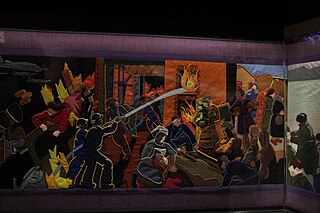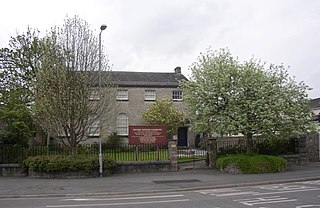
Embroidery is the art of decorating fabric or other materials using a needle to stitch thread or yarn. Embroidery may also incorporate other materials such as pearls, beads, quills, and sequins. In modern days, embroidery is usually seen on hats, clothing, blankets, and handbags. Embroidery is available in a wide variety of thread or yarn colour. It is often used to personalize gifts or clothing items.

The Bayeux Tapestry is an embroidered cloth nearly 70 metres long and 50 centimetres tall that depicts the events leading up to the Norman Conquest of England in 1066, led by William, Duke of Normandy challenging Harold II, King of England, and culminating in the Battle of Hastings. It is thought to date to the 11th century, within a few years of the battle. Now widely accepted to have been made in England perhaps as a gift for William, it tells the story from the point of view of the conquering Normans and for centuries has been preserved in Normandy.

The Overlord Embroidery, echoing the Bayeux Tapestry created 900 years before to commemorate the reverse invasion of England from Normandy, is a narrative embroidery that depicts the story of the D-Day Landings of 6 June 1944 and the subsequent Battle of Normandy. The story is told across 34 hand stitched panels running in total to 83 metres in length. The embroidery was created between 1968 and 1974, and is now on permanent display at The D-Day Story, Southsea, Portsmouth.

Crewel embroidery, or crewelwork, is a type of surface embroidery using wool. A wide variety of different embroidery stitches are used to follow a design outline applied to the fabric. The technique is at least a thousand years old.

Swarthmoor Hall is a mansion at Swarthmoor, in the Furness area of Cumbria, North West England. Furness is part of the historic county of Lancashire. The Hall was home to Thomas and Margaret Fell, the latter an important player in the founding of the Religious Society of Friends (Quaker) movement in the 17th century. It is designated by English Heritage as a Grade II* listed building. It remains in use today as a Quaker retreat house.

A shawl is a simple item of clothing, loosely worn over the shoulders, upper body and arms, and sometimes also over the head. It is usually a rectangular piece of cloth, but can also be square or triangular in shape. Other shapes include oblong shawls. It is associated with the inhabitants of the northern Indian subcontinent—particularly Kashmir and Punjab—and Central Asia, but can be found in many other parts of the world.

Quakers are people who belong to the Religious Society of Friends, a historically Protestant Christian set of denominations. Members of these movements are generally united by a belief in each human's ability to be guided by the inward light, "answering that of God in every one". Friends have traditionally professed a priesthood of all believers inspired by the First Epistle of Peter. They include those with evangelical, holiness, liberal, and traditional Quaker understandings of Christianity, as well as Nontheist Quakers. To differing extents, the Friends avoid creeds and hierarchical structures. In 2017, there were an estimated 377,557 adult Quakers, 49% of them in Africa.
Elizabeth Hooton was an English Dissenter and one of the earliest preachers in the Religious Society of Friends, also known as the Quakers. She was born in Nottingham, England. She was beaten and imprisoned for propagating her beliefs; she was the first woman to become a Quaker minister. She is considered one of the Valiant Sixty, a group of celebrated Friends preachers. Her surname is sometimes spelled Hooten.
The New World Tapestry was for a time the largest stitched embroidery in the world. It depicts English colonisation in North America, Guyanas, and Bermuda between the years 1583 and 1642, when the English Civil War began.

In embroidery, couching and laid work are techniques in which yarn or other materials are laid across the surface of the ground fabric and fastened in place with small stitches of the same or a different yarn.

English embroidery includes embroidery worked in England or by English people abroad from Anglo-Saxon times to the present day. The oldest surviving English embroideries include items from the early 10th century preserved in Durham Cathedral and the 11th century Bayeux Tapestry, if it was worked in England. The professional workshops of Medieval England created rich embroidery in metal thread and silk for ecclesiastical and secular uses. This style was called Opus Anglicanum or "English work", and was famous throughout Europe.

The Battle of Prestonpans Tapestry 1745, or simply the Prestonpans Tapestry, is a large embroidery created in 2010 in Prestonpans, East Lothian, Scotland. It depicts the events before, during and after the Battle of Prestonpans on 21 September 1745, when Bonnie Prince Charlie's Jacobite forces triumphed over the Hanoverian Army led by Sir John Cope. The design, size and style were inspired by the Bayeux Tapestry.

The Bayeux Tapestry tituli are Medieval Latin captions that are embroidered on the Bayeux Tapestry and describe scenes portrayed on the tapestry. These depict events leading up to the Norman conquest of England concerning William, Duke of Normandy, and Harold, Earl of Wessex, later King of England, and culminating in the Battle of Hastings.

The Game of Thrones Tapestry is a hand-crafted tapestry, woven by hand on a jacquard loom, with additional embroidery. The tapestry tells the entire story of the television show, Game of Thrones. It consists of seven 11-metre-long panels and one 10.5-metre panel. The eight panels depict scenes from each episode and include images of crew at work. The tapestry was commissioned by HBO and Tourism Ireland, the tourism bureau of Northern Ireland where HBO filmed much of the series.
Elizabeth Wardle (1834–1902) was an English embroiderer. In 1857 she married the silk dyer Thomas Wardle, a distant cousin. Thomas was later knighted for his services to the silk industry.
Elizabeth (Bessie) Burden was a British embroiderer and teacher. She was a member of the Arts and Crafts Movement, and worked for the embroidery department of Morris, Marshall, Faulkner & Co. She was the sister of Jane Morris and sister-in-law of the artist, designer and poet, William Morris.
Margaret Helen Swain was an English embroidery and textile historian. Trained as a nurse in London, she began a career as a historian after noticing no history about Ayrshire whitework embroidery in books following an exhibition at the Signet Library which she visited. Swain's research on the subject resulted in the publication of several books, she held two exhibitions, and wrote about embroidery, household textiles and tapestries in museum journals, magazines and newspapers. She was awarded an honorary Master of Arts degree from the University of Edinburgh in 1981. A pencil portrait of Swain was made by Elizabeth Blackadder and a collection of papers and objects related to her career are stored at National Museums Scotland.
Isabel Yeamans was an English Quaker preacher, and daughter of Margaret Fell and step-daughter of George Fox, co-founders of the Religious Society of Friends.
Bed hangings or bed curtains are fabric panels that surround a bed; they were used from medieval times through to the 19th century. Bed hangings provided privacy when the master or great bed was in a public room, such as the parlor. They also kept warmth in, and were a way of showing one's wealth. When bedrooms became more common in the mid-1700s, the use of bed hangings diminished.

Kendal Friends Meeting House is a Friends meeting house of the Religious Society of Friends (Quakers) in Kendal, Cumbria, in north-western England.

















